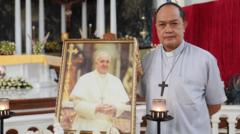The ongoing conclave at the Vatican, signified by black smoke from the Sistine Chapel, indicates the cardinals have yet to reach a consensus after a lengthy first night of voting. Crowds gather hopeful for a resolution as discussions on the future direction of the Catholic Church intensify.**
Vatican Conclave Continues as Black Smoke Signals Ongoing Impasse**

Vatican Conclave Continues as Black Smoke Signals Ongoing Impasse**
Voting among the 133 cardinals to select the next pope resumes amid heightened anticipation and long deliberations.**
The Vatican conclave enters its second day as black smoke poured from the Sistine Chapel chimney shortly before noon on Thursday, indicating that the cardinals have yet to agree on a new pope after several rounds of voting. This process began following the death of Pope Francis in April, marking the first conclave in over a decade.
On Wednesday night, the cardinals cast their votes for the first time, and the process was notably prolonged, taking over three hours. Speculations among observers suggest various reasons for this delay, including lengthy speeches and language barriers among some of the newer cardinals. As the voting resumes, the anticipation is palpable, with spectators gathering in St. Peter’s Square to observe the outcomes of the secret ballot.
The ongoing selection is unique, with this conclave featuring a diverse mix of cardinals appointed by the late pope, creating a blend of progressivism and conservatism within the group. Just recently, the conclave witnessed a ‘stemwinder’ of a meditation from a former papal preacher, which some say might have added to the session’s length.
Traditionally, cardinals engage in voting until a two-thirds majority of the 133 cardinals elect a new leader for the 1.4 billion Roman Catholics worldwide. The voting procedure employs a unique protocol of secrecy and manual ballot counting, and the results are signaled by colored smoke. If no pope is chosen today, additional rounds of voting are scheduled, maintaining hope that a resolution will arrive swiftly, albeit without guaranteed timeframes.
While earlier papal elections have concluded in as little as two days, some inside the conclave speculate that the sheer size and varying viewpoints within this cohort may lead to a prolonged process. Cardinal Timothy M. Dolan of New York mentioned he prepared provisions for a potentially longer wait than the quick selection in 2013.
Crowds in St. Peter’s Square reflect the historic significance of this moment, with many expressing hope and support for their preferred candidates, symbolizing the age-old tradition of the papal election, which remains a labyrinthine affair of intense deliberation, politics, and faith.
On Wednesday night, the cardinals cast their votes for the first time, and the process was notably prolonged, taking over three hours. Speculations among observers suggest various reasons for this delay, including lengthy speeches and language barriers among some of the newer cardinals. As the voting resumes, the anticipation is palpable, with spectators gathering in St. Peter’s Square to observe the outcomes of the secret ballot.
The ongoing selection is unique, with this conclave featuring a diverse mix of cardinals appointed by the late pope, creating a blend of progressivism and conservatism within the group. Just recently, the conclave witnessed a ‘stemwinder’ of a meditation from a former papal preacher, which some say might have added to the session’s length.
Traditionally, cardinals engage in voting until a two-thirds majority of the 133 cardinals elect a new leader for the 1.4 billion Roman Catholics worldwide. The voting procedure employs a unique protocol of secrecy and manual ballot counting, and the results are signaled by colored smoke. If no pope is chosen today, additional rounds of voting are scheduled, maintaining hope that a resolution will arrive swiftly, albeit without guaranteed timeframes.
While earlier papal elections have concluded in as little as two days, some inside the conclave speculate that the sheer size and varying viewpoints within this cohort may lead to a prolonged process. Cardinal Timothy M. Dolan of New York mentioned he prepared provisions for a potentially longer wait than the quick selection in 2013.
Crowds in St. Peter’s Square reflect the historic significance of this moment, with many expressing hope and support for their preferred candidates, symbolizing the age-old tradition of the papal election, which remains a labyrinthine affair of intense deliberation, politics, and faith.





















